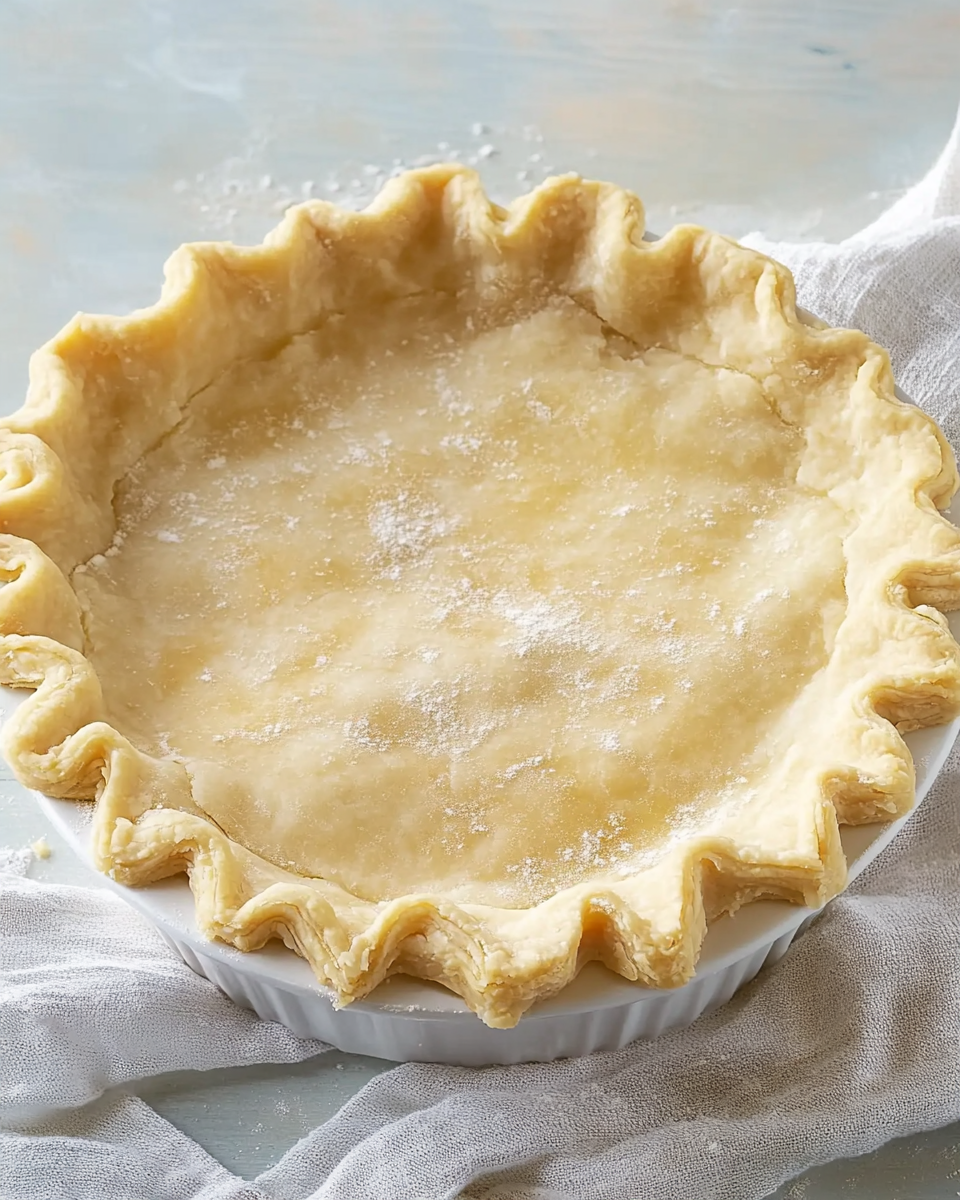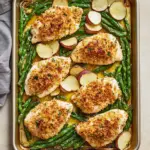Creating a perfect pie crust is a culinary skill that can elevate any pie, whether it’s a classic apple, a decadent chocolate cream, or a savory quiche. The buttery, flaky pie crust serves as the foundation of these delicious desserts and dishes, providing texture and flavor that complements the filling. Understanding the science behind the ingredients and techniques can help you achieve that coveted flaky texture and rich flavor.
Full Recipe:
Ingredients:
- 2 1/2 cups all-purpose flour
- 1 teaspoon salt
- 1 teaspoon sugar (optional, for sweet pies)
- 1 cup (2 sticks) unsalted butter, chilled and cut into small cubes
- 6 to 8 tablespoons ice water
Instructions:
- Combine Dry Ingredients: In a large bowl, whisk together the flour, salt, and sugar (if using).
- Add Butter: Add the chilled butter cubes to the flour mixture. Use a pastry cutter, fork, or your fingertips to cut the butter into the flour until the mixture resembles coarse crumbs, with some pea-sized pieces of butter remaining.
- Add Ice Water: Drizzle in the ice water, starting with 6 tablespoons. Mix gently with a fork until the dough starts to come together. Add more water, one tablespoon at a time, if needed.
- Form the Dough: Turn the dough out onto a lightly floured surface. Gather it into a ball and then flatten it into a disk. Wrap it in plastic wrap and refrigerate for at least 1 hour (or overnight).
- Roll Out the Dough: Once chilled, remove the dough from the fridge. On a floured surface, roll it out into a circle about 1/8 inch thick, ensuring it’s larger than your pie pan.
- Transfer to Pie Pan: Carefully transfer the rolled-out dough to your pie pan. Trim the excess dough hanging over the edges, and crimp the edges if desired.
- Pre-bake (if needed): If your recipe calls for a pre-baked crust, prick the bottom with a fork and bake at 375°F (190°C) for about 20 minutes, or until lightly golden.
Tips:
- Keep everything as cold as possible to ensure a flaky texture.
- Don’t overwork the dough; handle it just enough to bring it together.
- You can freeze the dough for up to 3 months if you want to make it ahead of time.
The Importance of Ingredients
Flour: All-purpose flour is the most commonly used flour for pie crusts. Its moderate protein content strikes a balance between tenderness and structure. For an even flakier crust, some bakers prefer to use a mix of all-purpose flour and pastry flour, which has a lower protein content, allowing for a more delicate texture.
Fat: The choice of fat is crucial. Unsalted butter is favored for its rich flavor and ability to create a flaky texture due to its water content, which turns to steam during baking. This steam creates layers in the dough, contributing to the flaky characteristic. Some bakers also incorporate shortening or lard for additional flakiness and tenderness, though this can alter the flavor profile.
Salt: A small amount of salt enhances the overall flavor of the crust. It’s a vital ingredient that should not be overlooked, as it balances the sweetness of the filling and brings depth to the dough.
Sugar: While optional, sugar can be added to sweet pie crusts to enhance flavor and browning. A small amount can make a significant difference, especially in desserts like fruit pies or tarts.
Water: Ice water is crucial in binding the ingredients together. It helps to keep the fat cold, which is essential for achieving flakiness. The ice-cold temperature prevents the butter from melting before it’s baked, ensuring that the steam created during baking puffs up the layers of dough.
Techniques for a Flaky Crust
Achieving a flaky pie crust is as much about technique as it is about ingredients. Here are some essential tips to keep in mind:
- Chill Your Ingredients: Keeping your butter, water, and even the flour cold is vital. Cold fat is key to creating those flaky layers. Some bakers even chill their mixing bowls and utensils before starting.
- Don’t Overmix: Overworking the dough can lead to a tough crust. Mix the ingredients just until they come together. It’s okay if there are small bits of butter remaining in the dough; these will melt and create flakiness when baked.
- Rest the Dough: Allowing the dough to rest in the refrigerator is essential. This resting period lets the gluten relax, making it easier to roll out and preventing shrinkage during baking.
- Roll Out with Care: When rolling out the dough, use a light touch and rotate the dough frequently to ensure an even thickness. If the dough becomes too soft or warm, return it to the fridge for a short time to firm up.
- Pre-Baking (Blind Baking): For certain pies, pre-baking the crust ensures that it doesn’t become soggy from moist fillings. Use pie weights or dried beans to keep the crust from puffing up during this process.
Common Challenges and Solutions
Even experienced bakers can encounter challenges when making pie crusts. Here are a few common issues and how to solve them:
- Tough Crust: This often results from overworking the dough or using too much water. Remember to handle the dough gently and add water sparingly.
- Soggy Bottom: A soggy crust can occur if the filling is too moist or if the crust isn’t pre-baked. Consider blind baking or adding a layer of flour or breadcrumbs to absorb moisture.
- Shrinking Crust: This can happen if the dough is stretched too much when placed in the pie pan or if it wasn’t allowed to rest adequately. Make sure to roll it out gently and let it chill before baking.
Creative Variations
While a classic buttery, flaky crust is perfect for many pies, there are countless variations you can explore:
- Whole Wheat Crust: Substitute part or all of the all-purpose flour with whole wheat flour for a nuttier flavor and added nutrition.
- Nut Crust: Ground nuts such as almonds or pecans can be mixed into the crust for added flavor and texture, perfect for certain types of pies.
- Herbed Crust: For savory pies, consider incorporating fresh or dried herbs into the dough. This adds an aromatic element that complements fillings like quiche or pot pie.
Conclusion
Mastering the art of a buttery, flaky pie crust opens up a world of possibilities in the kitchen. By understanding the role of each ingredient and the techniques involved, you can create a pie crust that not only supports but enhances your favorite fillings. Whether you’re baking a traditional dessert for a family gathering or experimenting with savory options for a dinner party, a well-made pie crust can make all the difference.
With practice, patience, and a bit of creativity, you’ll be able to craft delicious pies that are as beautiful as they are flavorful. Embrace the process, and soon you’ll be known for your exceptional pie crusts, impressing family and friends with your culinary prowess. Happy baking!






